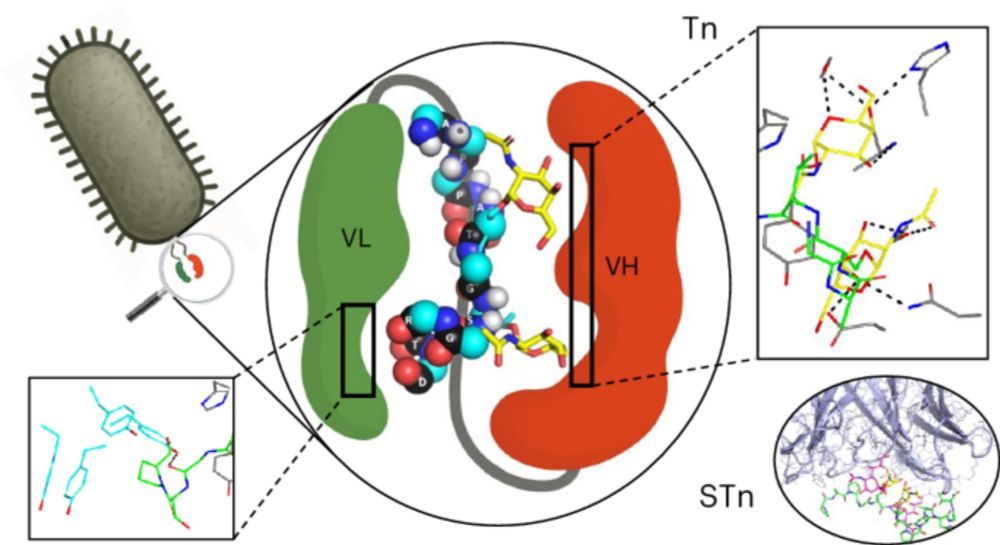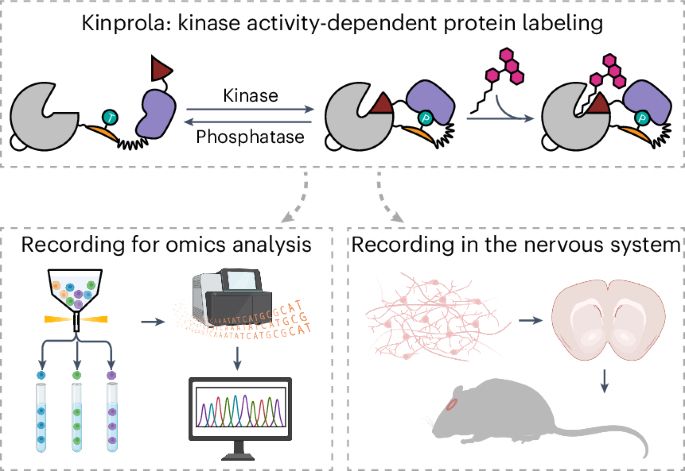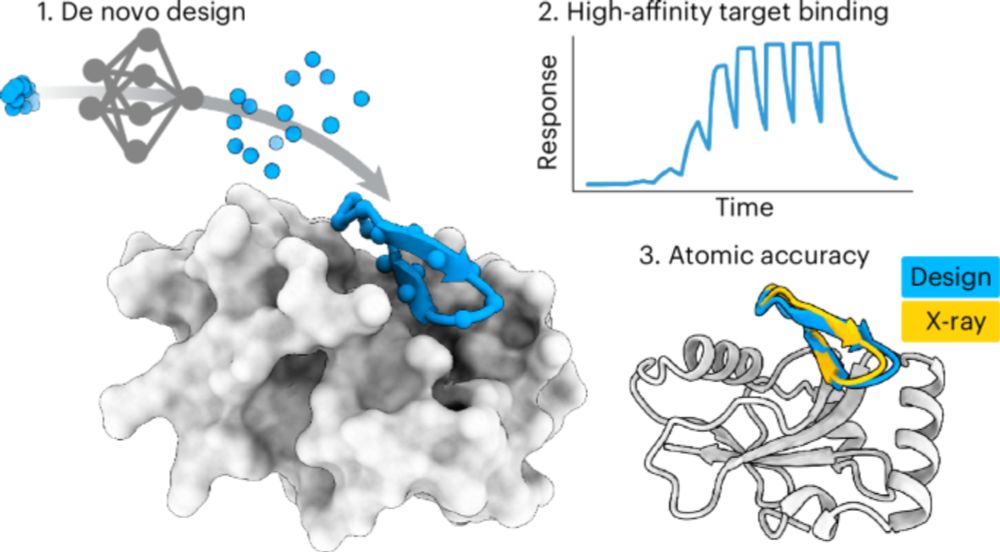
Gene Chong
@chongg.bsky.social
Senior Editor at Nature Chemical Biology handling #glycotime, #lipidtime, immunology, microbiology, protein engineering, #synbio, #computational. Formerly a comp chemist simulating various things. Based in DC.
The fusion of intrinsically disordered regions to CARs enhances CAR-T signaling by inducing CAR condensation and enhances CAR sensitivity to low-antigen-expressing cancer cells
www.nature.com/articles/s41...
www.nature.com/articles/s41...

IDR-induced CAR condensation improves the cytotoxicity of CAR-Ts against low-antigen cancers - Nature Chemical Biology
Low-antigen-expressing cancers are a challenge to existing chimeric antigen receptor (CAR)-T cell-based therapies. Now, it has been shown that fusion of intrinsically disordered regions to CARs induces CAR condensation and enhances antigen sensitivity and killing activity of CAR-T cells.
www.nature.com
September 29, 2025 at 3:56 PM
The fusion of intrinsically disordered regions to CARs enhances CAR-T signaling by inducing CAR condensation and enhances CAR sensitivity to low-antigen-expressing cancer cells
www.nature.com/articles/s41...
www.nature.com/articles/s41...
I loved this simulation-guided paper with reaaally state-of-the-art simulations at first sight 😍
Are the lipids associated with static protein structures there as long-lived ligands or an effect of preferential solvation? This computational-experimental framework shows the way! #lipidtime #compchem
www.nature.com/articles/s41...
www.nature.com/articles/s41...

Molecular basis for the regulation of membrane proteins through preferential lipid solvation - Nature Chemical Biology
Static protein structures can capture the association of lipids, but it is unclear whether the association is due to lipids acting as long-lived ligands or the solvation of preferred lipids around the protein. A computational-experimental framework has now shown that for the protein CLC-ec1, it is the change in lipid solvation energies that drives dimerization, with preferred lipids around the protein modulating this driving force.
www.nature.com
September 26, 2025 at 3:32 PM
I loved this simulation-guided paper with reaaally state-of-the-art simulations at first sight 😍
Are the lipids associated with static protein structures there as long-lived ligands or an effect of preferential solvation? This computational-experimental framework shows the way! #lipidtime #compchem
www.nature.com/articles/s41...
www.nature.com/articles/s41...

Molecular basis for the regulation of membrane proteins through preferential lipid solvation - Nature Chemical Biology
Static protein structures can capture the association of lipids, but it is unclear whether the association is due to lipids acting as long-lived ligands or the solvation of preferred lipids around the protein. A computational-experimental framework has now shown that for the protein CLC-ec1, it is the change in lipid solvation energies that drives dimerization, with preferred lipids around the protein modulating this driving force.
www.nature.com
September 26, 2025 at 3:29 PM
Are the lipids associated with static protein structures there as long-lived ligands or an effect of preferential solvation? This computational-experimental framework shows the way! #lipidtime #compchem
www.nature.com/articles/s41...
www.nature.com/articles/s41...
Engineered bispecific Notch agonists “pull” on and mechanically activate Notch receptors in the presence of desired biomarkers
www.nature.com/articles/s41...
www.nature.com/articles/s41...

Engineering synthetic agonists for targeted activation of Notch signaling - Nature Chemical Biology
The development of soluble Notch agonists is a challenge because of the mechanical forces needed to activate Notch receptors. Here, bispecific Notch agonist proteins were designed that ‘pull’ on and activate Notch receptors in the presence of desired biomarkers.
www.nature.com
September 24, 2025 at 8:46 PM
Engineered bispecific Notch agonists “pull” on and mechanically activate Notch receptors in the presence of desired biomarkers
www.nature.com/articles/s41...
www.nature.com/articles/s41...
Reposted by Gene Chong
Very excited to share new work out today in @natchembio.nature.com on a new approach - FACES - for selectively imaging of phospholipids and other biomolecules at spatial resolutions down to individual membrane leaflets (1/n) www.nature.com/articles/s41...

Leaflet-specific phospholipid imaging using genetically encoded proximity sensors - Nature Chemical Biology
An approach combining bioorthogonal chemistry with genetically encoded fluorogen-activating proteins enables subcellular imaging of phospholipids and glycans, as well as the visualization of lipid tra...
www.nature.com
September 15, 2025 at 6:03 PM
Very excited to share new work out today in @natchembio.nature.com on a new approach - FACES - for selectively imaging of phospholipids and other biomolecules at spatial resolutions down to individual membrane leaflets (1/n) www.nature.com/articles/s41...
The design of STAT biosensors enables real-time tracking of STAT activation in live cells, inhibitor screening, and probing the activity of cancer-associated STAT mutants
www.nature.com/articles/s41...
www.nature.com/articles/s41...

Real-time visualization of STAT activation in live cells using genetically encoded biosensors - Nature Chemical Biology
The signal transducer and activator of transcription (STAT) family proteins are attractive drug targets but tools to monitor their activation are lacking. Now, STAT biosensors have been developed for ...
www.nature.com
September 8, 2025 at 8:47 PM
The design of STAT biosensors enables real-time tracking of STAT activation in live cells, inhibitor screening, and probing the activity of cancer-associated STAT mutants
www.nature.com/articles/s41...
www.nature.com/articles/s41...
Arginylation is a post-translational modification that is difficult to distinguish from arginine residues using mass spec. Now a method has been developed to profile protein arginylation ex vivo
www.nature.com/articles/s41...
www.nature.com/articles/s41...

An unbiased proteomic platform for ATE1-based arginylation profiling - Nature Chemical Biology
Arginylation is a post-translational modification that is difficult to distinguish from arginine residues using mass spectrometry. Now a method has been developed to profile protein arginylation ex vi...
www.nature.com
August 27, 2025 at 5:46 PM
Arginylation is a post-translational modification that is difficult to distinguish from arginine residues using mass spec. Now a method has been developed to profile protein arginylation ex vivo
www.nature.com/articles/s41...
www.nature.com/articles/s41...
The Red Hen in DC for Italian food. I had to wait a month for the reservation! Worth it




August 18, 2025 at 11:17 PM
The Red Hen in DC for Italian food. I had to wait a month for the reservation! Worth it
#glycotime #immunology Structure-guided design rules for antibodies targeting cancer antigens with Tn and STn epitopes
www.nature.com/articles/s41...
www.nature.com/articles/s41...

Structure-guided phage display discovery of antibodies for (S)Tn-glycans in protein context - Nature Chemical Biology
Structural studies of certain Tn and STn antigen-targeting antibodies reveal that their VH and VL domains recognize the glycan antigen and the adjacent peptide region, respectively, enabling a VH doma...
www.nature.com
August 1, 2025 at 7:50 PM
#glycotime #immunology Structure-guided design rules for antibodies targeting cancer antigens with Tn and STn epitopes
www.nature.com/articles/s41...
www.nature.com/articles/s41...
A new paper reports that the primary mechanism of capsaicin entry into the vanilloid-binding site of TRPV1 is a targetable hydrophobic tunnel at the TRPV1-membrane interface
www.nature.com/articles/s41...
www.nature.com/articles/s41...

Mechanism of capsaicin entry into buried vanilloid sites in TRPV1 - Nature Chemical Biology
The primary entry route of vanilloid ligands to the vanilloid-binding site in transient receptor potential vanilloid 1 (TRPV1) is found to be a distinct and targetable hydrophobic pathway at the TRPV1...
www.nature.com
July 28, 2025 at 8:11 PM
A new paper reports that the primary mechanism of capsaicin entry into the vanilloid-binding site of TRPV1 is a targetable hydrophobic tunnel at the TRPV1-membrane interface
www.nature.com/articles/s41...
www.nature.com/articles/s41...
#glycotime Legionella effector LtpM is found to recognize strict two-residue sequons for site-specific O-glucosylation with minimal perturbations to a target protein and is used to show that O-glucose can act as a constitutively active O-GlcNAc mimic
www.nature.com/articles/s41...
www.nature.com/articles/s41...

Protein β-O-glucosylation by Legionella LtpM through short consensus sequons G-T/S and S-G - Nature Chemical Biology
Legionella effector LtpM is found to recognize short two-residue sequons, enabling site-specific O-glucosylation with minimal perturbations to a target protein, and is used to show that O-glucose can ...
www.nature.com
July 15, 2025 at 6:32 PM
#glycotime Legionella effector LtpM is found to recognize strict two-residue sequons for site-specific O-glucosylation with minimal perturbations to a target protein and is used to show that O-glucose can act as a constitutively active O-GlcNAc mimic
www.nature.com/articles/s41...
www.nature.com/articles/s41...
Reposted by Gene Chong
Molecular recording of cellular protein kinase activity with chemical labeling:
www.nature.com/articles/s41...
Congratulations to De-en Sun and the entire team.
www.nature.com/articles/s41...
Congratulations to De-en Sun and the entire team.

Molecular recording of cellular protein kinase activity with chemical labeling - Nature Chemical Biology
Molecular recorders based on kinase activity-dependent protein labeling track specific kinase activities to understand their link to cellular phenotypes in heterogeneous cell populations and in vivo.
www.nature.com
July 10, 2025 at 5:46 PM
Molecular recording of cellular protein kinase activity with chemical labeling:
www.nature.com/articles/s41...
Congratulations to De-en Sun and the entire team.
www.nature.com/articles/s41...
Congratulations to De-en Sun and the entire team.
Reposted by Gene Chong
The newest paper from the lab is now out @natchembio.nature.com! A hard-won effort by Rebecca and @xujunc.bsky.social uncovers a previously undescribed post-translationally modified site that regulates STING signaling and proposes a new strategy for inhibition.
www.nature.com/articles/s41...
www.nature.com/articles/s41...

Cysteine allostery and autoinhibition govern human STING oligomer functionality - Nature Chemical Biology
Palmitoylation at C64 in stimulator of interferon genes (STING) is reported and, along with engagement of C91, is involved in dynamic cross talk with C148 to alter STING oligomer states and ultimately...
www.nature.com
July 3, 2025 at 3:18 PM
The newest paper from the lab is now out @natchembio.nature.com! A hard-won effort by Rebecca and @xujunc.bsky.social uncovers a previously undescribed post-translationally modified site that regulates STING signaling and proposes a new strategy for inhibition.
www.nature.com/articles/s41...
www.nature.com/articles/s41...
oh god 😖 🤦🏻♂️
"At FDA we're accelerating drug approvals so that you don't need to use primates or even animal models. You can do the drug approvals very, very quickly with AI."
July 1, 2025 at 7:48 PM
oh god 😖 🤦🏻♂️
A new paper from the Institute for Protein Design at UW presents RFpeptides, an extension of RoseTTAFold2 and RFdiffusion for de novo design of macrocyclic peptide binders
www.nature.com/articles/s41...
www.nature.com/articles/s41...

Accurate de novo design of high-affinity protein-binding macrocycles using deep learning - Nature Chemical Biology
A method for de novo design of peptide macrocyles called RFpeptides has been developed. RFpeptides is an extension of RoseTTAFold2 and RFdiffusion and combines structure prediction and protein backbon...
www.nature.com
June 23, 2025 at 4:54 PM
A new paper from the Institute for Protein Design at UW presents RFpeptides, an extension of RoseTTAFold2 and RFdiffusion for de novo design of macrocyclic peptide binders
www.nature.com/articles/s41...
www.nature.com/articles/s41...
Another cool protein eng. paper for you -- Designed "chauffeurs" shuttle transporters and integral membrane enzymes folded in the ER to the peroxisomal membrane. This expands the repertoire of biosynthetic pathways that can be compartmentalized in the peroxisome
www.nature.com/articles/s41...
www.nature.com/articles/s41...

Functional targeting of membrane transporters and enzymes to peroxisomes - Nature Chemical Biology
A modular protein engineering strategy was developed to shuttle transporters and integral membrane enzymes folded in the endoplasmic reticulum to the peroxisomal membrane. This approach expands the re...
www.nature.com
June 17, 2025 at 4:30 PM
Another cool protein eng. paper for you -- Designed "chauffeurs" shuttle transporters and integral membrane enzymes folded in the ER to the peroxisomal membrane. This expands the repertoire of biosynthetic pathways that can be compartmentalized in the peroxisome
www.nature.com/articles/s41...
www.nature.com/articles/s41...
and check out the associated News & Views by Yang Zhou, Xiaoding Ma, and Haifeng Ye on the innovations of this chemically induced proximity system called SAMBA
www.nature.com/articles/s41...
www.nature.com/articles/s41...
June 13, 2025 at 7:36 PM
and check out the associated News & Views by Yang Zhou, Xiaoding Ma, and Haifeng Ye on the innovations of this chemically induced proximity system called SAMBA
www.nature.com/articles/s41...
www.nature.com/articles/s41...
A highly compact chemically induced proximity system dependent on salicylic acid or aspirin enables control of biological processes and cellular therapeutics using an over-the counter drug with minimal side effects
www.nature.com/articles/s41...
www.nature.com/articles/s41...

Repurposing salicylic acid as a versatile inducer of proximity - Nature Chemical Biology
A highly compact chemically induced proximity system dependent on salicylic acid or aspirin enables control of biological processes and cellular therapeutics using an over-the-counter drug with minima...
www.nature.com
June 13, 2025 at 7:36 PM
A highly compact chemically induced proximity system dependent on salicylic acid or aspirin enables control of biological processes and cellular therapeutics using an over-the counter drug with minimal side effects
www.nature.com/articles/s41...
www.nature.com/articles/s41...
“if it is allowed…” 😞
Two out of every three people with Alzheimer’s are women, and the greatest risk factor after old age is being a woman. A Nature Outlook article shows how a decade of research studying the effects of sex and gender on the disease is starting to bear fruit. #medsky #alzsky 🧪

Why women experience Alzheimer’s disease differently from men
Sex and gender research could lead to better, more equitable treatments — if it is allowed to continue without political interference.
go.nature.com
June 7, 2025 at 4:34 PM
“if it is allowed…” 😞
c-di-AMP is found to be a second messenger in eukaryotes generated by ADCY7 and connects TLR9 stimulation to NLRP3 inflammasome activation #immunology #ChemBio
www.nature.com/articles/s41...
www.nature.com/articles/s41...

Eukaryotic ADCY7 catalyzes the production of c-di-AMP to activate the NLRP3 inflammasome - Nature Chemical Biology
Cyclic dimeric adenosine monophosphate is found to be a second messenger in eukaryotic cells that is generated by adenylate cyclase 7 and connects Toll-like receptor 9 stimulation to nucleotide-bindin...
www.nature.com
May 28, 2025 at 6:50 PM
c-di-AMP is found to be a second messenger in eukaryotes generated by ADCY7 and connects TLR9 stimulation to NLRP3 inflammasome activation #immunology #ChemBio
www.nature.com/articles/s41...
www.nature.com/articles/s41...
My first Memorial Day Weekend spread 🤤

May 23, 2025 at 3:23 AM
My first Memorial Day Weekend spread 🤤
It’s #lipidtime. The authors capture oscillations in the abundance of different phospholipid species during the yeast cell cycle, suggesting regulation and interplay of phospholipid synthesis, membrane fluidity, and metabolic efficiency during cell division
www.nature.com/articles/s41...
www.nature.com/articles/s41...

Temporal oscillation of phospholipids promotes metabolic efficiency - Nature Chemical Biology
Temporal oscillations in the abundance of different phospholipid species during the yeast cell cycle are reported, suggesting regulation and interplay of phospholipid synthesis, membrane fluidity and ...
www.nature.com
April 14, 2025 at 4:07 PM
It’s #lipidtime. The authors capture oscillations in the abundance of different phospholipid species during the yeast cell cycle, suggesting regulation and interplay of phospholipid synthesis, membrane fluidity, and metabolic efficiency during cell division
www.nature.com/articles/s41...
www.nature.com/articles/s41...
Here to report UltraSelex which uses single-round selection and ranking algorithm for high-affinity RNA aptamer discovery #RNA #ChemBio #chemsky #drugdiscovery
www.nature.com/articles/s41...
www.nature.com/articles/s41...

Single-step discovery of high-affinity RNA ligands by UltraSelex - Nature Chemical Biology
A method called UltraSelex for identifying RNA aptamers has been developed. UltraSelex is noniterative and can combine biochemical partitioning, high-throughput sequencing and computational signal-to-...
www.nature.com
April 14, 2025 at 3:39 PM
Here to report UltraSelex which uses single-round selection and ranking algorithm for high-affinity RNA aptamer discovery #RNA #ChemBio #chemsky #drugdiscovery
www.nature.com/articles/s41...
www.nature.com/articles/s41...
Reposted by Gene Chong
We’re starting to be able to see larger-scale multimers of mRNA species, and it’s a whole new world to explore:

RNA Motifs Coming Into Focus
www.science.org
April 10, 2025 at 5:50 PM
We’re starting to be able to see larger-scale multimers of mRNA species, and it’s a whole new world to explore:
A first-in-class inhibitor of the PASB domain of circadian regulator BMAL1 is reported with an important tie-in to the crosstalk between circadian biology and immunology #chemsky #ChemBio
www.nature.com/articles/s41...
www.nature.com/articles/s41...

Pharmacological targeting of BMAL1 modulates circadian and immune pathways - Nature Chemical Biology
The authors developed a small molecule targeting the circadian regulator BMAL1, enabling dose-dependent modulation of gene expression for circadian-controlled genes and downregulation of inflammatory ...
www.nature.com
March 27, 2025 at 3:17 PM
A first-in-class inhibitor of the PASB domain of circadian regulator BMAL1 is reported with an important tie-in to the crosstalk between circadian biology and immunology #chemsky #ChemBio
www.nature.com/articles/s41...
www.nature.com/articles/s41...

